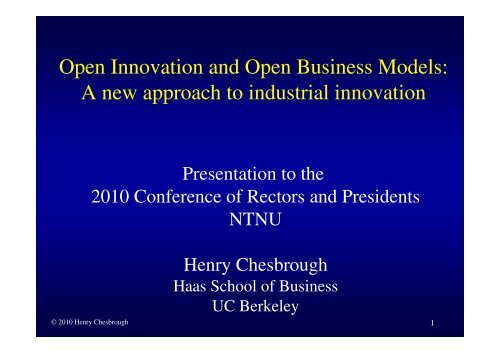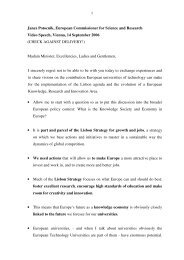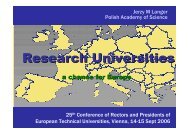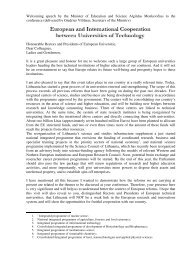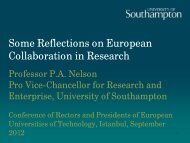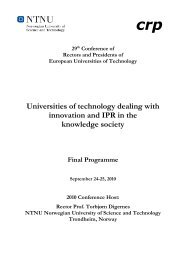Open Innovation and Open Business Models - Conference of ...
Open Innovation and Open Business Models - Conference of ...
Open Innovation and Open Business Models - Conference of ...
You also want an ePaper? Increase the reach of your titles
YUMPU automatically turns print PDFs into web optimized ePapers that Google loves.
<strong>Open</strong> <strong>Innovation</strong> <strong>and</strong> <strong>Open</strong> <strong>Business</strong> <strong>Models</strong>:<br />
A new approach to industrial innovation<br />
Presentation to the<br />
2010 <strong>Conference</strong> <strong>of</strong> Rectors <strong>and</strong> Presidents<br />
NTNU<br />
Henry Chesbrough<br />
Haas School <strong>of</strong> <strong>Business</strong><br />
UC Berkeley<br />
© 2010 Henry Chesbrough 1
A Thought Experiment<br />
• It is the year 1900. You have a pr<strong>of</strong>itable<br />
business, <strong>and</strong> it is growing<br />
• To your credit, you recognize that this<br />
won’t last forever<br />
• Where to look for ideas that can grow into a<br />
future business?<br />
© 2010 Henry Chesbrough 2
Henry Rowl<strong>and</strong>’s* Lament<br />
“…what must be done [is] to create a science <strong>of</strong><br />
physics in this country, rather than to call<br />
telegraphs, electric lights, <strong>and</strong> such<br />
conveniences by the name <strong>of</strong> science….<br />
When the highest honors are given to the<br />
mediocre, when third-class men are held up<br />
as examples, <strong>and</strong> when trifling inventions are<br />
magnified into scientific discoveries, then the<br />
influence <strong>of</strong> such societies is prejudicial.”<br />
* address as President <strong>of</strong> the American Academy for the<br />
Advancement <strong>of</strong> Science, 1883<br />
© 2010 Henry Chesbrough 3
Where Were the Great Ideas for<br />
<strong>Innovation</strong> 50 or 100 years ago?<br />
• Individual Inventors<br />
• Lots <strong>of</strong> imitators<br />
• A few very large companies’ R&D labs<br />
• “The key [to success] is to find a man <strong>of</strong><br />
genius, give him money, <strong>and</strong> leave him<br />
alone.”<br />
– James Conant, former President, Harvard Univ.<br />
© 2010 Henry Chesbrough 4
The Current Paradigm: A Closed<br />
<strong>Innovation</strong> System<br />
Science<br />
&<br />
Technology<br />
Base<br />
The<br />
Market<br />
Research<br />
Investigations<br />
R<br />
Development<br />
New Products<br />
/Services<br />
© 2010 Henry Chesbrough 5<br />
D
The Virtuous Circle for R&D<br />
Fundamental Technology<br />
Breakthroughs<br />
Increased<br />
investment<br />
in R&D<br />
New Products <strong>and</strong><br />
Features<br />
Increased Sales <strong>and</strong><br />
Pr<strong>of</strong>its via existing<br />
business model<br />
© 2010 Henry Chesbrough 6
The same experiment today<br />
• Public repositories <strong>of</strong> knowledge<br />
– Google<br />
– Public Library <strong>of</strong> Science<br />
• Faculty - <strong>and</strong> their graduate students<br />
• Growing number <strong>of</strong> excellent universities<br />
around the world<br />
• Growing number <strong>of</strong> patents received<br />
globally<br />
© 2010 Henry Chesbrough 7
Where are the Great Ideas today?<br />
• Users/Individual Inventors<br />
• Startups <strong>and</strong> SMEs<br />
• Universities <strong>and</strong> Research Institutes<br />
• Some large companies<br />
• Nonpr<strong>of</strong>it organizations, foundations<br />
• “Not all the smart people in the world work<br />
for you.”<br />
– Bill Joy, founder, Sun Microsystems, now<br />
Partner at Kleiner Perkins.<br />
© 2010 Henry Chesbrough 8
Where is R&D Occurring?<br />
© 2010 Henry Chesbrough 9
The <strong>Open</strong> <strong>Innovation</strong> Paradigm<br />
Licensing<br />
Other Firm’s<br />
Market<br />
Internal<br />
Technology<br />
Base<br />
External<br />
Technology<br />
Base<br />
R<br />
Technology Spin-<strong>of</strong>fs<br />
Technology Insourcing<br />
Current<br />
Market<br />
© 2010 Henry Chesbrough 10<br />
D<br />
New<br />
Market
Closed <strong>Open</strong> innovation<br />
Internal<br />
technology base<br />
Other firm´s<br />
market<br />
Licence, spin<br />
out, divest<br />
Our new<br />
market<br />
External technology<br />
base<br />
© 2010 Henry Chesbrough<br />
Internal/external<br />
venture h<strong>and</strong>ling<br />
External technology<br />
insourcing<br />
Stolen with pride from Pr<strong>of</strong> Henry Chesbrough UC Berkeley, <strong>Open</strong> <strong>Innovation</strong>: Renewing Growth from<br />
Industrial R&D, 10th Annual <strong>Innovation</strong> Convergence, Minneapolis Sept 27, 2004<br />
Our current<br />
market
The Logic <strong>of</strong> “<strong>Open</strong> <strong>Innovation</strong>”<br />
• Good ideas are widely distributed today. No one has a<br />
monopoly on useful knowledge anymore.<br />
• Being first to discover is neither necessary nor<br />
sufficient to win in the market<br />
• A better business model beats a better technology<br />
• Universities are now critical players in the innovation<br />
process<br />
• Not all <strong>of</strong> the smart people in the world work for us.<br />
© 2010 Henry Chesbrough 12
Implications for Industry-University<br />
Research Collaborations<br />
• Industry is Retreating from Basic Research<br />
• Universities are Picking Up the Slack<br />
• Are Universities Set Up to Work as the Lab for<br />
Industry?<br />
– Is this consistent with the mission <strong>of</strong> the<br />
university?<br />
• Are Companies Set Up to Work with Universities?<br />
– Can companies pr<strong>of</strong>it from university work?<br />
© 2010 Henry Chesbrough 13
Correlating Nation’s (2009)<br />
% <strong>of</strong> WW GDP to % <strong>of</strong> WW Top-Ranked Universities<br />
9<br />
8<br />
Japan<br />
7<br />
6<br />
y = 0,7489x + 0,3534<br />
R² = 0,719<br />
China<br />
Germany<br />
% global GDP<br />
5<br />
4<br />
Italy<br />
France<br />
United Kingdom<br />
3<br />
2<br />
1<br />
Russia<br />
India<br />
Mexico<br />
Turkey<br />
Brazil<br />
Spain<br />
South Korea<br />
Netherl<strong>and</strong>s<br />
Sweden<br />
Australia<br />
Canada<br />
0<br />
0 1 2 3 4 5 6 7 8 9<br />
% top 500 universities<br />
US is still “<strong>of</strong>f the chart” – China projected to be “<strong>of</strong>f the chart” in less than 10 years:<br />
US % <strong>of</strong> WW Top-Ranked Universities: 30,3 %<br />
US % <strong>of</strong> WW GDP: 23,3 %<br />
Source: http://www.arwu.org/ARWUAnalysis2009.jsp
The role <strong>of</strong> the university<br />
Impact <strong>of</strong> the universities<br />
Source: Pellenbarg, 2005
Universities as <strong>Open</strong> Institutions<br />
• Universities are intended to explore,<br />
discover, <strong>and</strong> disseminate new knowledge<br />
• Society expects that, over time, much <strong>of</strong> this<br />
new knowledge will be useful<br />
• Post World War II, government<br />
increasingly funded university research<br />
© 2010 Henry Chesbrough 16
U.S. Federal Government R&D History<br />
Homel<strong>and</strong> Security,<br />
Reagan “Star<br />
Wars” Program<br />
JFK<br />
Apollo<br />
Program<br />
Carter<br />
Energy<br />
Program<br />
© 2010 Henry Chesbrough<br />
M. Hoeffert<br />
17<br />
Courtesy <strong>of</strong> Chris Somerville
The Public Research University<br />
• The Morrill Act (1862):<br />
– "An Act Donating Public L<strong>and</strong>s<br />
to the Several States <strong>and</strong><br />
Territories which may provide<br />
Colleges for the Benefit <strong>of</strong><br />
Agriculture <strong>and</strong> the Mechanic<br />
Arts“<br />
• Explicitly intended to advance<br />
technology <strong>and</strong> serve the working<br />
classes<br />
© 2010 Henry Chesbrough 18
Universities as Industry Research<br />
Partners<br />
• Bayh-Dole Act <strong>of</strong> 1980 – universities can<br />
claim an ownership right to its discoveries<br />
• University research discoveries sometimes<br />
vital to industry activities<br />
– E.g., Cohen Boyer patent on recombinant DNA<br />
– $255 million paid, product sales <strong>of</strong> >$25 billion<br />
© 2010 Henry Chesbrough 19
Balancing <strong>Open</strong>ness <strong>and</strong> Industry<br />
Needs: A Proposed Continuum<br />
<strong>Open</strong><br />
Restricted<br />
Gifts<br />
Commons<br />
Consortia<br />
Grants<br />
Research<br />
Contracts<br />
Overhead $, IP rights<br />
Adapted from Carol Mimura presentation, 9/29/2008<br />
© 2010 Henry Chesbrough 20
Can This Scale?<br />
Will Universities Be “Bought” if<br />
Funding is High Enough?<br />
• Energy Biosciences Institute an Interesting<br />
Case<br />
• Significant $, some controversy<br />
• Some institutional innovation<br />
• Some corporate innovation as well…<br />
© 2010 Henry Chesbrough 22
BP’s challenge in February 2006<br />
• Energy Bioscience looked promising (Senior Executive buy-in)<br />
• How do we meld commercial/technology strength with<br />
biology/biotech?<br />
− The company had no bio-expertise<br />
• How to reach out to biology/biotech communities<br />
− Not a corporate lab!<br />
− Corporate labs too insular – can’t tap broader expertise in a<br />
rapidly moving field<br />
− Where was the Energy/Bio talent pool anyway?<br />
− Not the usual university research programme<br />
− BP does many <strong>of</strong> these <strong>and</strong> knows strengths/weaknesses<br />
− Need to facilitate the development, demonstration, <strong>and</strong><br />
commercialization <strong>of</strong> research results<br />
© 2010 Henry Chesbrough<br />
23
BP Organizational Choices to Make This<br />
Valuable<br />
• A substantial <strong>and</strong> long-term commitment to engage quality researchers<br />
($500m over 10 years)<br />
• Host at a world-class institution to maximize academic presence <strong>and</strong><br />
interdisciplinary interaction.<br />
• Single organization doing open <strong>and</strong> proprietary work<br />
− <strong>Open</strong> work in Fundamental Energy Biosciences<br />
− In best academic tradition<br />
− Need faculty help in inventing the field<br />
− A window for BP on worldwide Energy Biosciences<br />
− Co-locate some BP researchers<br />
− Live in <strong>and</strong> underst<strong>and</strong> the open research community, but knowledgeable<br />
about BP’s needs, goals<br />
− Enhance industry connection to help motivate/guide open research<br />
− Potential to demonstrate at scale<br />
© 2010 Henry Chesbrough<br />
24
Funding for <strong>Open</strong> <strong>and</strong> Proprietary Components<br />
contracts<br />
$50M/yr<br />
contracts<br />
subcontracts<br />
UC Berkeley<br />
Host Institution<br />
$35M/yr<br />
BP<br />
Proprietary Component<br />
contracts<br />
Lawrence Berkeley<br />
National Laboratory<br />
subcontracts<br />
ENERGY BIOSCIENCES INSTITUTE (EBI)<br />
OPEN RESEARCH<br />
University <strong>of</strong> Illinois<br />
Urbana-Champaign<br />
Other<br />
BP Components<br />
$15M/yr<br />
BP R&T<br />
PROPRIETARY RESEARCH<br />
Other<br />
Entities<br />
contracts<br />
© 2010 Henry Chesbrough<br />
25
Is this compatible with a public research<br />
university?<br />
• Does EBI preserve academic freedom?<br />
• Does Berkeley remain an open institution?<br />
• Will society benefit from EBI, or will BP be the main<br />
beneficiary?<br />
• Who controls the assignment <strong>of</strong> research projects?<br />
• Who controls the IP generated by the research?<br />
• Who controls the dissemination <strong>of</strong> research results?<br />
© 2010 Henry Chesbrough<br />
26
EBI governance <strong>and</strong> oversight<br />
Governance Board<br />
UCB/UIUC/LBNL - 4 representatives<br />
BP - 4 representatives<br />
Scientific Advisory<br />
Board<br />
Strategic Science<br />
Advisors<br />
5 Research<br />
Leaders<br />
EBI (UCB)<br />
Director<br />
(Chris Somerville)<br />
Executive Committee<br />
EBI (UIUC)<br />
Deputy Director<br />
(Steve Long)<br />
EBI (BP)<br />
Assoc. Director<br />
(Paul Willems)<br />
Energy Biosciences<br />
Institute<br />
<strong>Open</strong> Research Programs<br />
BP R&T<br />
Proprietary<br />
Research Programs<br />
© 2010 Henry Chesbrough<br />
27
Licensing provisions<br />
For inventions solely owned by UCB, UIUC <strong>and</strong>/or LBNL<br />
NON-EXCLUSIVE<br />
Non-exclusive, royal free (NERF)<br />
license in BP’s area <strong>of</strong> interest,<br />
providing:<br />
- BP will diligently pursue<br />
commercialization<br />
- BP will underwrite the patent<br />
costs<br />
EXCLUSIVE<br />
BP may obtain exclusive license<br />
rights to sole or joint inventions.<br />
- pre-negotiated capped fees<br />
- “Bonanza clause” in case <strong>of</strong><br />
extraordinary commercial<br />
success<br />
© 2010 Henry Chesbrough<br />
28
Assessment<br />
• Who controls the<br />
assignment <strong>of</strong><br />
research projects?<br />
• Who controls the IP<br />
generated from the<br />
research?<br />
• Who controls the<br />
dissemination <strong>of</strong> the<br />
research results?<br />
© 2010 Henry Chesbrough<br />
29
Assessment – Academic Freedom<br />
• Who controls the<br />
assignment <strong>of</strong><br />
research projects?<br />
• Who controls the IP<br />
generated from the<br />
research?<br />
• Who controls the<br />
dissemination <strong>of</strong> the<br />
research results?<br />
• Executive Committee<br />
proposes, Governance<br />
Board approves – Berkeley<br />
<strong>and</strong> BP each have veto over<br />
slate<br />
• Yours, Mine, <strong>and</strong> Ours<br />
• Berkeley controls, subject to<br />
patent decision<br />
© 2010 Henry Chesbrough<br />
30
Assessment – Part II: Academic Impact<br />
• Is Berkeley better or<br />
worse <strong>of</strong>f for having<br />
this agreement?<br />
• Would other<br />
universities accept<br />
these provisions?<br />
• Will taxpayers view<br />
this agreement<br />
positively?<br />
© 2010 Henry Chesbrough<br />
31
Assessment – Part II<br />
• Is Berkeley better or<br />
worse <strong>of</strong>f for having<br />
this agreement?<br />
• Would other<br />
universities accept<br />
these provisions?<br />
• Will taxpayers view<br />
this agreement<br />
positively?<br />
• Yes – 10 new<br />
faculty positions,<br />
dozens <strong>of</strong> grad<br />
students supported<br />
• In a heartbeat; 4<br />
other finalists<br />
• Tougher question.<br />
If no, may further<br />
reduce research<br />
funding support<br />
© 2010 Henry Chesbrough<br />
32
BP Assessment – Is this more than charity?<br />
• What is BP getting<br />
for its $500M?<br />
• How will BP learn<br />
from UCB <strong>and</strong> UI<br />
research?<br />
• How will results<br />
transfer into useful<br />
industry<br />
development?<br />
© 2010 Henry Chesbrough<br />
33
BP Assessment – Is this more than charity?<br />
• What is BP getting<br />
for its $500M?<br />
• How will BP learn<br />
from UCB <strong>and</strong> UI<br />
research?<br />
• How will results<br />
transfer into useful<br />
industry<br />
development?<br />
• BP is buying speed,<br />
<strong>and</strong> access to world<br />
class bioscience<br />
• BP must invest<br />
additional resources to<br />
learn<br />
• BP must create new<br />
receiving mechanisms<br />
inside BP to make use<br />
<strong>of</strong> results<br />
© 2010 Henry Chesbrough<br />
34
A Critique <strong>of</strong> EBI, <strong>and</strong> Similar Large Scale<br />
Corporate Research Collaborations<br />
• Even if the form <strong>of</strong> academic freedom is preserved in such<br />
agreements, the substance in practice can still thwart<br />
academic freedom<br />
1.“Relevant” research (from the perspective <strong>of</strong> the<br />
corporation) will be selected over “less relevant” research<br />
2.The additional resources will likely reinforce the favored<br />
trajectory <strong>of</strong> research, especially new faculty appointments<br />
<strong>and</strong> doctoral grants<br />
3.The faculty who bring in such resources may be favored<br />
over those who do not<br />
4.Over time, the faculty will become “pro corporate” (<strong>and</strong><br />
Berkeley is a State-supported University)<br />
© 2010 Henry Chesbrough<br />
35
Could This be a New Model for Industry-University Collaboration?<br />
Named a “Deal <strong>of</strong> Distinction” in 2007<br />
In The Industry-University-Government Interface (IUGI) Sector<br />
By the Licensing Executive’s Society<br />
“…h<strong>and</strong> sculpted glass by the artisans<br />
<strong>of</strong> Parris-Roche Design Studios,<br />
consisting <strong>of</strong> a pair <strong>of</strong> entwined blue<br />
glass ribbons encased in a<br />
clear conic pinnacle symbolic <strong>of</strong><br />
parties coming together…”<br />
© 2010 Henry Chesbrough<br />
36
Backup slides<br />
© 2010 Henry Chesbrough<br />
39
Setting the Stage<br />
• In 2004 Restructured IP management at Berkeley<br />
• Created IPIRA, goal <strong>of</strong> streamlining processes & increasing<br />
corporate sponsored research<br />
• IP Management Strategies<br />
to Maximize Research Impact, Collaboration & Translation<br />
• Relationship model: collaborations, partnerships are key<br />
• Networks are key<br />
• Logo reflects the vitality <strong>and</strong> interconnectivity <strong>of</strong> the Industry-<br />
University interface<br />
© 2010 Henry Chesbrough<br />
40
In 2006: Opportunity to Compete for Funding from BP<br />
“Help us to invent the future”<br />
The RFP was consistent with Berkeley’s approach in IPIRA<br />
Most common definition <strong>of</strong> technology transfer is not consistent with our<br />
approach<br />
Our approach is expansive, embraces <strong>Open</strong> <strong>Innovation</strong> principles<br />
TT is an ongoing relationship continuum, not a single transaction<br />
•many years, many points <strong>of</strong> contact<br />
•building a pyramid, contributing<br />
different sectors <strong>of</strong> a pie<br />
•results from inflows <strong>and</strong> outflows<br />
to <strong>and</strong> from the university<br />
•involving personnel exchange, knowledge exchange, materials <strong>and</strong><br />
equipment, expertise <strong>and</strong> know-how exchange in both directions<br />
© 2010 Henry Chesbrough<br />
41
Research Complementarity<br />
© 2010 Henry Chesbrough<br />
42
Berkeley Resources<br />
<br />
<br />
Joint Genome Institute<br />
National Energy Research<br />
Supercomputing Center<br />
<br />
<br />
Molecular Foundry<br />
National Center for Electron<br />
Microscopy<br />
<br />
<br />
Cryo-EM Facility<br />
QB3 NMR Facility<br />
© 2010 Henry Chesbrough<br />
43
WHAT IS THE EBI?<br />
INTEGRATING PROGRAMS<br />
Under One Ro<strong>of</strong><br />
Projects<br />
Programs<br />
Feedstock<br />
Development<br />
Feedstock<br />
Deconstruction<br />
Fuel<br />
Synthesis<br />
Environment,<br />
Economics & Policy<br />
© 2010 Henry Chesbrough<br />
44
Relevant Facilities at<br />
University IL at Urbana-Champaign<br />
Institute for Genomic<br />
Biology<br />
Germplasm collections<br />
Bioprocessing facility<br />
Off-road vehicle<br />
development laboratory<br />
Network <strong>of</strong> experimental<br />
stations & energy farm<br />
© 2010 Henry Chesbrough<br />
45
EBI <strong>Open</strong> <strong>and</strong> Proprietary Components Help Us<br />
To Implement a Shared Vision<br />
Of translating basic, academic, research results from the EBI<br />
into global energy solutions<br />
Science-to-technology transition can be expedited through<br />
innovative Public-Private Partnerships<br />
Bench to bedside<br />
Bench to fuel tank<br />
QuickTime <strong>and</strong> a<br />
TIFF (Uncompressed) decompressor<br />
are needed to see this picture.<br />
University as innovation accelerator<br />
Engineering <strong>and</strong> Agriculture:<br />
• input from industry provides valuable insight<br />
• problems to be solved<br />
• where <strong>and</strong> how academics can help<br />
© 2010 Henry Chesbrough<br />
46
EBI timeline<br />
• June 14, 2006<br />
− BP announced publicly its intention to create the EBI<br />
• Summer 2006<br />
− Screening <strong>of</strong> some 52 inquiries in 10 countries<br />
• October 2006<br />
− RFP to 5 potential hosts (three in the US <strong>and</strong> two in the UK)<br />
− Encourage partnership to bring strength across whole value chain<br />
• Early December 2006<br />
− Reverse site visits in London by a BP panel<br />
• February 1, 2007<br />
− Selection <strong>of</strong> UCB/UIUC/LBNL announced<br />
• Spring-Fall 2007<br />
− Contract negotiations / Partner meetings re governance / EBI Directors in<br />
place / Pre-proposals → proposals → funding decisions<br />
• November 14, 2007<br />
− Contract formally signed, operations begin<br />
© 2010 Henry Chesbrough<br />
47


